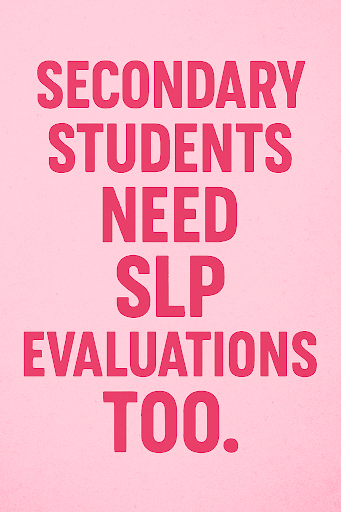How to Evaluate a Middle or High School Student for Language Disorders
Age-appropriate assessment strategies for identifying language disorders in older students

Evaluating a teenager for a language disorder can feel like stepping into a different universe.
They're verbal. They've made it this far. They might have decent grades or solid social skills. So why are they being referred?
Because secondary students with language disorders often fall through the cracks — and by the time they reach middle or high school, the signs can be subtle but serious.
This article will guide you through:
- What makes evaluating adolescents unique
- What to look for beyond surface-level scores
- What assessments actually work for this age group
- How to make your evaluation meaningful (and legally sound)
Why Older Students Get Missed
Early evaluations tend to focus on:
- Articulation
- Grammar
- Basic vocabulary
But as language demands increase, students may struggle with:
- Abstract reasoning
- Inferences and figurative language
- Complex sentence construction
- Organizing ideas in essays
- Understanding classroom lectures or dense texts
These are the language foundations that support literacy, executive function, and academic success — and they're often overlooked until middle school teachers flag poor writing, inconsistent comprehension, or vague verbal expression.
Step 1: Reframe Your Clinical Lens
Adolescents don't "sound" language impaired — but they may:
- Give one-word answers
- Avoid complex verbal reasoning
- Struggle to summarize, explain, or compare
- Rely on memorized phrases or filler words
- Struggle with transitions in writing or conversation
Look beyond whether they can "talk" — and focus on whether they can use language to learn, connect, and advocate for themselves.
Step 2: Choose Assessments That Fit the Age and Context
Here are some great tools for evaluating language in older students:
✅ Standardized Tests
- CELF-5 Metalinguistics (ages 9–21): targets inferences, multiple meanings, and figurative language
- TILLS: comprehensive and age-appropriate for academic skills
- CASL-2: good for pragmatic, syntactic, and supralinguistic analysis
- OWLS-II: includes written expression subtests
✅ Informal Tools
- Writing samples: Ask for an open-ended paragraph (e.g., "What's your opinion on school uniforms?")
- Narrative retells: Gauge coherence, grammar, sequencing
- Listening comprehension tasks: Use classroom texts
- Interviews: Ask open-ended questions about school, friendships, and goals
These reveal breakdowns in cohesion, syntax, vocabulary retrieval, and metacognitive language.
Step 3: Observe Executive Function Intersections
Many teens referred for "language" issues actually struggle with:
- Organization
- Planning
- Mental flexibility
- Self-monitoring
These aren't speech-language disorders per se, but they do impact academic communication — and can be addressed via language strategies, metalinguistic goals, and accommodations.
Step 4: Include Their Voice
Teens often know they're struggling — they just don't have the words for it.
Ask them:
- "What's hardest about school right now?"
- "When do you feel like you don't understand what's being asked?"
- "What's easy for you, and what's hard?"
- "Do you ever feel like you know what you want to say, but can't get it out?"
These answers give you insight into self-awareness, internal language, and expressive barriers.
Step 5: Write a Report That Educators Will Actually Use
When reporting findings:
- Include classroom impacts: writing quality, class discussion participation, reading comprehension
- Translate scores into functional outcomes ("difficulty with multiple meanings may affect test-taking and figurative language in novels")
- Suggest realistic accommodations: chunking instructions, graphic organizers, rubrics for writing
And if the student qualifies for services, include goals that help them:
- Participate in discussions
- Clarify misunderstandings
- Expand written language
- Develop self-advocacy skills
SLP Score Helps You Capture the Full Picture
Middle and high school evaluations take time — and often require more nuance.
SLP Score lets you:
- Auto-score tests like the CELF-5, CASL-2, and more
- Write up narrative interpretations in family- and educator-friendly language
- Document informal observations and writing samples
- Export everything in editable formats — no formatting battles
Whether you're supporting a high schooler through their first eval or documenting a requal, SLP Score makes the process faster, clearer, and more clinically sound.
Adolescent Language Disorders Are Real
And they deserve real evaluations. Get started with SLP Score and ensure every teenage evaluation captures the complexity they need.
Get Started Here →